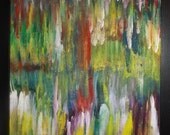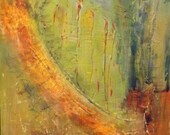Now that the leather is dry and formed to the shape you want, it's time to move on to the stitching.
|
|
| The tool on the very bottom is an awl. It's used to pierce the holes for stitching. The second tool is an 'overstitch wheel.' The points on the wheel lightly mark the leather where the stitches will go to keep them even. Dampen the edge of the leather slightly with a sponge & run the wheel along where your line of stitching will be. Then you can pierce holes with the awl. I've already punched holes for all the stitching along the length of the penner and the lid. |
 |
| The brown lump at the bottom is beeswax. I've used it quite a bit, so there are many grooves and bits of color where I've drawn threads across it to wax them. |
Here's an easy youtube video that shows how to wax your thread before you start stitching:
https://www.youtube.com/watch?v=ReIkIF8AFes
I'm using linen thread. In this case the thread is white. When I dye the finished penner, the thread will also pick up the dye to match (or at least that's the theory.) I'm also using a curved needle which makes it easier to stitch without having to get your hand inside the penner. I'll try to put up some diagrams of the actual stitch pattern, but until I get those drawn up, here are a couple web sites that show the 'baseball' stitch I'm using.
Baseball stitch: https://www.youtube.com/watch?v=kahlJ31s2I8
Actual stitch on a baseball: https://www.youtube.com/watch?v=nLY-wZ2jOTQ
Same stitch with a little different tools and techniques:
https://www.youtube.com/watch?v=FPk8BDRLJZg
 |
Here's the lid of the penner.
It's sitting on another small flat piece of leather. |
Trace around the bottom of the penner and the top of the lid. Cut out the two rectangles. You'll need to round the corners a little bit, the leather never seems to make a perfectly square corner.
 |
| Here are all the pieces so far. You'll also notice that I 'fixed' the penner by adding the channels for the cords. I had forgotten to do that on this penner before I stitched it closed. |
Bevel the edges of the small rectangles. Also bevel the edges of the top of the lid and the bottom of the penner. Ideally, you'll have a 45 degree angle so the pieces will fit snugly together. I use an X-acto knife for this. Make sure you have a sharp blade. I can make about one penner before I have to change out the knife blade.
Here's a closer view of the lid next to it's beveled and shaped top. It's difficult to see, but the top edge of the lid is also beveled.
 |
| The two beveled edges fit together and the needle/stitching passes right through the angle. If I were perfect, the stitches would not show on the inside at all (not going to happen.) |
 |
| Here's the lid with it's top. |
 |
I put the lid back onto the wooden form for stitching.
Makes it a little easier to hold while you're stitching.
You can see I've marked & punched the stitching holes already.
|
 |
| Here's the top of the lid partially stitched. You can stitch this with 2 needles, but I'm doing a running stitch and then 'filling in' between the running stitches on the second time around the seam. I think that's called a 'double-running' stitch in fabric. Not sure what leather workers call it. I started with a knot on the outside (the threads are sticking out next to the needle). When I get all the way around the second time, I'll back stitch 2 or 3 stitches & cut off all the thread ends. The backstitching will hold everything in place. |
 |
| Here's a closeup of the finished stitching. |
 |
| You're stitching through the top and sides at the same time. Here you can also see that the leather is darker around the stitches. That's because it's damp. The damp leather is easier to stitch or pierce with the awl. You can also smooth out some of the tool marks with a bone folder while the leather is damp. So if you've accidentally made a couple of dents with your needle or left fingernail marks, dampen the leather & smooth them out before you let it dry. |
 |
| Bottom of penner & top of lid all stitched up. |
 |
| This strip of leather has been damped and folded around the wooden form. |
 |
| It will form the 'lip' that holds the lid in place. Fit it inside the penner and trim it so it fits tightly inside the penner with about a half inch showing. |
 |
| Use the awl to pierce stitching holes through the penner & the lip insert. Hold them tightly & pierce straight through. (I made the holes in a sort of decorative pattern. I just liked the irregular stitch lengths.) |
 |
| Once you've stitched the lip in place, let everything dry. You see here how the lid of the penner slips over the lip. |
 |
| Penner with lid in place. Next comes the finishing, dye, top coat of sealant and the cords to hang it from your belt. |
Comments Welcome!
Or sign up for email or notifications.
(See sidebar on right.)
I'd love to hear what you think.
 |
| This is the dye brand I'm using. The cotton dauber is in the middle. I'm using red. |
 |
| Here's a test scrap of leather. Wipe the leather down with rubbing alcohol and a clean rag to remove greasy finger prints and smudges. This is called 'deglazing' the leather. There are also special deglazing formulas you can buy, but rubbing alcohol works fine. |
 |
| Next, wipe down the leather with a bit of oil on a paper towel. I read about this online. That leatherworker recommended jojoba oil, but I didn't have any of that handy. You just want a very light coat. I tried dyeing without doing this step and the color was uneven and blotchy. Big difference when oiling the leather first. |
Next I'll get some pictures of the sample piece with dye, adding the cord, and the finished penner.





























